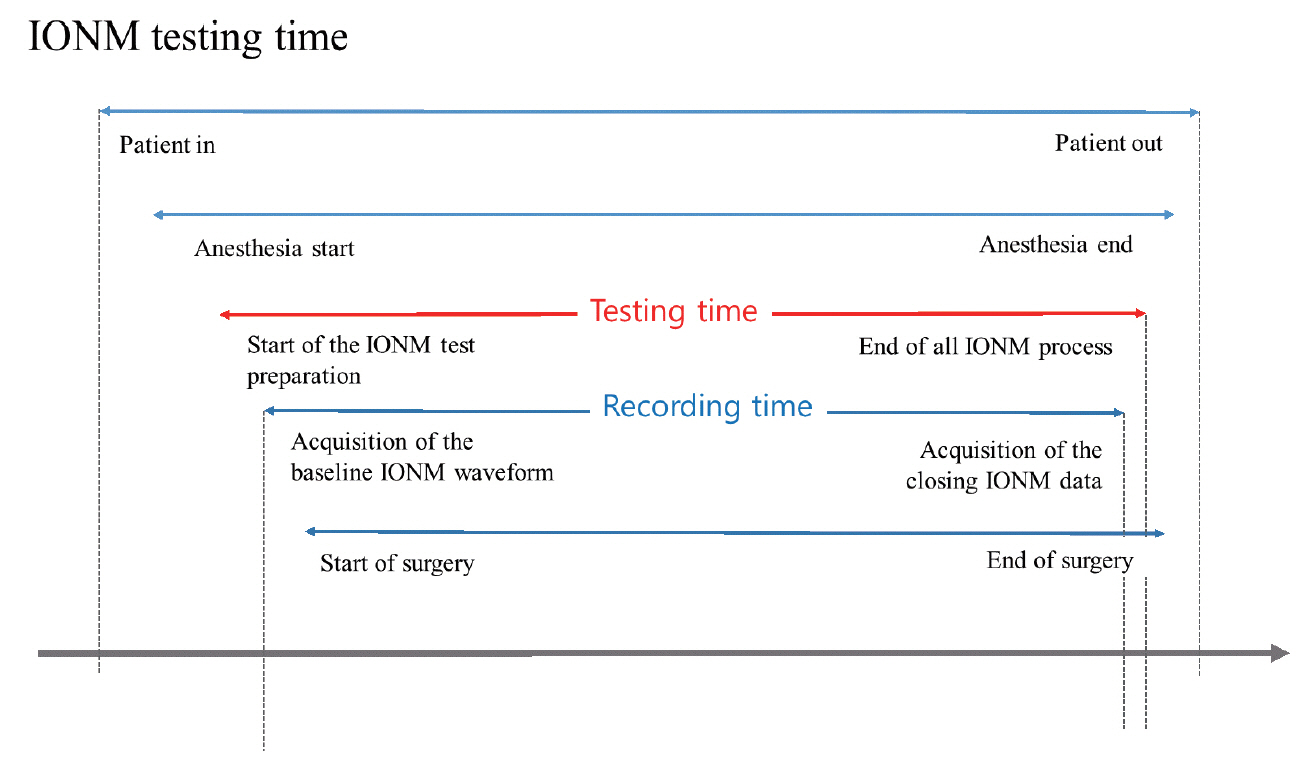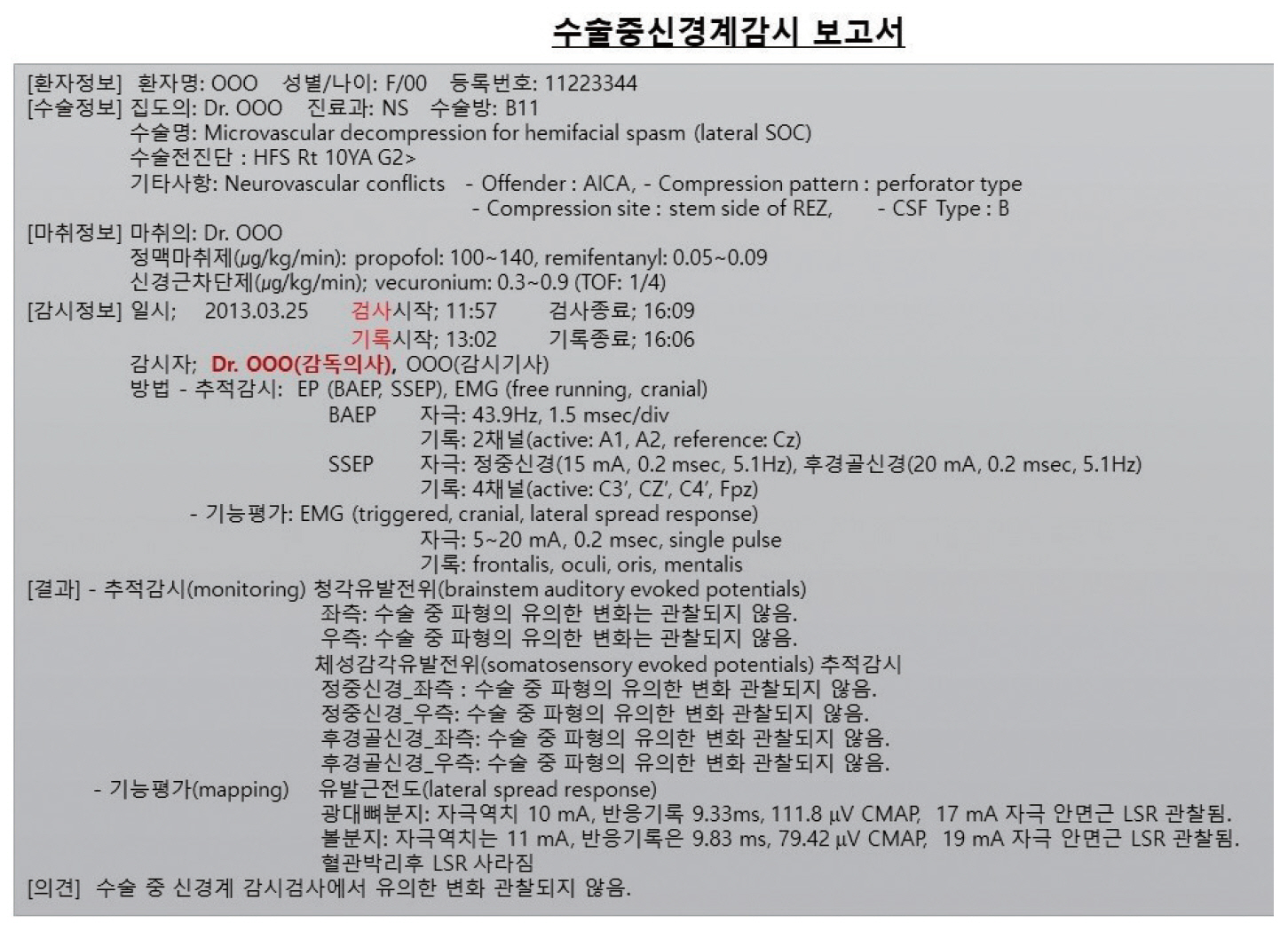Ann Clin Neurophysiol.
2021 Apr;23(1):35-45. 10.14253/acn.2021.23.1.35.
Clinical practice guidelines for intraoperative neurophysiological monitoring: 2020 update
- KMID: 2515606
- DOI: http://doi.org/10.14253/acn.2021.23.1.35
Abstract
- The utility and accuracy of intraoperative neurophysiological monitoring (IONM) has evolved greatly following the recent development of new devices for neurophysiological testing and advances in anesthesiology. Until recently, the need for IONM services has been limited to large academic hospitals, but the demand for neurophysiologists with expertise in IONM has grown rapidly across diverse types of hospital. The primary goal of the Korean Society of Intraoperative Neurophysiological Monitoring (KSION) is to promote the development of IONM research groups and to contribute to the improvement of fellowship among members and human health through academic projects. These guidelines are based on extensive literature reviews, recruitment of expert opinions, and consensus among KSION board members. This version of the guidelines was fully approved by the KSION, Korean Association of EMG Electrodiagnostic Medicine, the Korean Society of Clinical Neurophysiology, the Korean Academy of Rehabilitation Medicine, and the Korean Neurological Association.
Figure
Reference
-
1. Kim SM, Kim SH, Seo DW, Lee KW. Intraoperative neurophysiological monitoring: basic principles and recent update. J Korean Med Sci. 2013; 28:1261–1269.2. American Association of Neuromuscular and Electrodiagnostic Medicine. AANEM POSITION STATEMENT: The Role of the Intraoperative Monitoring Team. Available from: http://www.aanem.org/getmedia/44fbb8e3-27db-44e8-90df-81797109be2f/IOM-MonitoringTeam_000.pdf.aspx.3. American Academy of Neurology. Principles of coding for intraoperative neurophysiological monitoring (IOM) and testing [Internet]. Minneapolis, (MN, USA): American Academy of Neurology;c2018. [accessed 2020 Mar 31]. Available from: https://www.aan.com/siteassets/home-page/tools-and-resources/practicing-neurologist--administrators/billing-and-coding/model-coverage-policies/18iommodelpolicy_tr.pdf.4. Department of Health and Human Services Physician Supervision of Diagnostic Tests. Available from: http://www.aarc.org/members_area/advocacy/federal/md_supervision_tests.pdf.5. Nuwer MR. Intraoperative monitoring of neural function. 1st ed. London: Elsevier;2008. p. 1–980.6. Nuwer JM, Nuwer MR. Neurophysiologic surgical monitoring staffing patterns in the USA. Electroencephalogr Clin Neurophysiol. 1997; 103:616–620.
Article7. Greiner A, Mess WH, Schmidli J, Debus ES, Grommes J, Dick F, et al. Cyber medicine enables remote neuromonitoring during aortic surgery. J Vasc Surg. 2012; 55:1227–1233.
Article8. Husain A. A practical approach to neurophysiologic intraoperative monitoring. 1st ed. New York: Demos Medical Publishing;2008. p. 1–528.9. MacDonald D. Safety of intraoperative transcranial electrical stimulation motor evoked potential monitoring. J Clin Neurophysiol. 2002; 19:416–429.
Article10. Rothwell J, Burke D, Hicks R, Stephen J, Woodforth I, Crawford M. Transcranial electrical stimulation of the motor cortex in man: further evidence for the site of activation. J Physiol. 1994; 481(Pt 1):243–250.
Article11. Scheufler KM, Zentner J. Total intravenous anesthesia for intraoperative monitoring of the motor pathways: an integral view combining clinical and experimental data. J Neurosurg. 2002; 96:571–579.
Article12. Kochs E, Treede R, Schulte EJ. Increase in somatosensory evoked potentials during anesthesia induction with etomidate. Der Anaesthesist. 1986; 35:359–364.13. Randolph GW, Dralle H; International Intraoperative Monitoring Study Group, Abdullah H, Barczynski M, Bellantone R, et al. Electrophysiologic recurrent laryngeal nerve monitoring during thyroid and parathyroid surgery: international standards guideline statement. Laryngoscope. 2011; 121 Suppl 1:S1–S16.
Article14. Szelényi A, Kothbauer KF, Deletis V. Transcranial electric stimulation for intraoperative motor evoked potential monitoring: stimulation parameters and electrode montages. Clin Neurophysiol. 2007; 118:1586–1595.
Article15. Deletis V, Sala F. Intraoperative neurophysiological monitoring of the spinal cord during spinal cord and spine surgery: a review focus on the corticospinal tracts. Clin Neurophysiol. 2008; 119:248–264.
Article16. Burke D, Hicks R, Stephen J, Woodforth I, Crawford M. Trial-to-trial variability of corticospinal volleys in human subjects. Electroencephalogr Clin Neurophysiol. 1995; 97:231–237.
Article17. Kothbauer KF, Deletis V, Epstein FJ. Motor-evoked potential monitoring for intramedullary spinal cord tumor surgery: correlation of clinical and neurophysiological data in a series of 100 consecutive procedures. Neurosurg Focus. 1998; 4:e1.
Article18. Sakaki K, Kawabata S, Ukegawa D, Hirai T, Ishii S, Tomori M, et al. Warning thresholds on the basis of origin of amplitude changes in transcranial electrical motor-evoked potential monitoring for cervical compression myelopathy. Spine (Phila Pa 1976). 2012; 37:E913–E921.
Article19. Szelényi A, Hattingen E, Weidauer S, Seifert V, Ziemann U. Intraoperative motor evoked potential alteration in intracranial tumor surgery and its relation to signal alteration in postoperative magnetic resonance imaging. Neurosurgery. 2010; 67:302–313.
Article20. Kim SM, Yang H, Park SB, Han SG, Park KW, Yoon SH, et al. Pattern-specific changes and discordant prognostic values of individual leg-muscle motor evoked potentials during spinal surgery. Clin Neurophysiol. 2012; 123:1465–1470.
Article21. James ML, Husain AM. Brainstem auditory evoked potential monitoring: when is change in wave V significant? Neurology. 2005; 65:1551–1555.
Article22. Gunnarsson T, Krassioukov AV, Sarjeant R, Fehlings MG. Real-time continuous intraoperative electromyographic and somatosensory evoked potential recordings in spinal surgery: correlation of clinical and electrophysiologic findings in a prospective, consecutive series of 213 cases. Spine (Phila Pa 1976). 2004; 29:677–684.
Article
- Full Text Links
- Actions
-
Cited
- CITED
-
- Close
- Share
- Similar articles
-
- Preservation of the superior laryngeal nerve without neuromonitoring during thyroid surgery
- Mechanisms underlying brain monitoring during anesthesia: limitations, possible improvements, and perspectives
- Intraoperative Neurophysiologic Monitoring: Basic Principles and Recent Update
- Intraoperative monitoring of somatosensory and visual evoked potentials for detecting posterior cerebral artery infarction during anteromesial temporal resection
- Early Detection of the Internal Capsule Infarction by Intraoperative Neuromonitoring in Mesial Temporal Epilepsy Surgery



